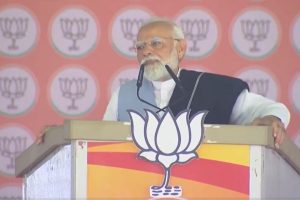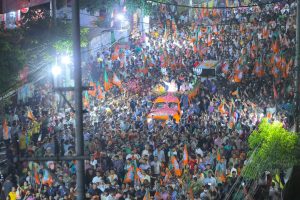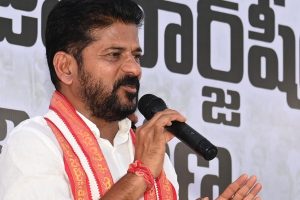The farmers think that Budget 2022 is revenge against them by the Central government over the farm laws. The budget has cut allocations in both agriculture and rural development, in a situation where a substantial section of the population lives in the rural areas. It has displeased the middle class because there is no provision in the budget for increasing aggregate consumption and thereby increasing jobs for them.
India’s economy contracted by 7.3 per cent in 2020, the highest contraction among the world economies whereas the world economy as a whole contracted by 3.1 per cent. Open unemployment was already at an all-time high at 8.8 per cent. The only increase that may increase employment is a rise of capital expenditure to 2.9 per cent in 2022-23 from 1.3 per cent in 2021-22. But this will primarily boost the profits of construction companies and create jobs for low-skilled construction workers.
Moreover, this increase in capital expenditure will be financed principally by raising prices of petrol, diesel and gas and further feed inflation, which is already running at around six per cent. Given that most middle-class incomes are inelastic and there has been no rise in exemptions in personal income tax, this will further eat into real earnings of the middle class.
Compared to the revised estimates for 2021-22, total expenditure is projected to increase in nominal terms by 4.6 per cent in 2022-23 to Rs 39,44,909 crore. This actually means that total expenditure will decline given the current rate of inflation. Food subsidies are also slated to decline sharply from Rs 4,62,789 crore in 2020-21 to Rs 1,45,920 crore in 2022-23, This demonstrates insensitivity to the problem of chronic hunger in India, when in respect of the Hunger Index, India ranks even lower than most of the Sub-Saharan countries.
Why are teachers dissatisfied despite an increase of 11.96 per cent in allocation to education compared with last year’s budget? Education does see an increase in allocation but this is not being used to hire more teachers, despite around 11 lakh pending appointments of teachers to which the budget makes no reference.
The allocation will go towards expansion of “one class-one TV channel” from 12 to 200 in different languages. What was needed was a much larger allocation for appointment of teachers in schools and colleges and expansion of infrastructure of educational institutions in view of the huge learning gap. Instead of that the focus is on e-vidya and establishment of an e-university. First of all, these are future-looking programmes whereas the urgent need is the huge learning gap caused by the pandemic.
Secondly, as of September 2021 only 8 per cent of the children were studying online. In a country in which children of poor families, especially those of SC/ST parents don’t even have smartphones with which to access virtual classes, it is a mockery to try to bridge the learning gap through e-vidya initiatives.
There is a fundamental difference between conducting online classes and using electronic/digital means for academic activities, including teaching. The first requires students to be present at a specific time and participate in classes in real time; the latter allows students to download teaching-learning material and communicate with teachers as per their convenience. This must be kept in mind at all times, given the wide diversity of social and economic backgrounds of most students.
In actual classrooms students can socialize with other students and can grow up as responsible citizens of our diverse country. This does not happen with online classes, particularly when they are conducted by elite institutions. With poor connectivity of students of ST and SC communities, they will hardly benefit for these programmes, while they will benefit the private sector. Moreover, scholarships for Higher Education for Young Achievers Scheme (SHREYAS) for SCs had its allocation reduced from 450 crore in BE 2021-2022 to 364 crore.
The allocation for SHREYAS for the OBCs and the Economically Backward Classes was also reduced from ?130 crore in 2021-2022 to ?80 crore. Now let us look at the situation of employment. India’s official rate of unemployment as noted above, in 2019-20 was 8.8 per cent. But this figure does not give the true picture. Take Bihar as an example; 1.25 core aspirants had applied for over 35,000 posts advertised by Railway Recruitment Board for the Group C services. Rough estimates by the state government show that the maximum number of applicants were from UP and Bihar. There is a dip of almost 30 per cent in UPSC jobs. In Bihar, the case of the Staff Selection Commission or SSC is worse. There were 20,000 vacancies in SSC in 2013, which declined to 12,000 in 2018 and there are currently 8,000-9,000 vacancies only.
The FM implicitly recognised the problem of joblessness when she said early in her speech that the Union government plans to create six million jobs over the next five years. One, about five million young people, mostly educated, join the labour force looking for work each year. Two, there were already 30 million unemployed in 2019 – and at least 10 million have been added to that number since the Covid-19 pandemic began. And three, 32 million semi- and unskilled migrant labourers went back to agriculture between 2019 and 2020 and received little succour. The last development is a reversal of the trend of the absolute reduction of workers in agriculture between 2004- 05 and 2019.
(The writer is a distinguished economist, former Professor of Economics, Presidency College, Kolkata, and Emeritus Professor, Institute of Development Studies Kolkata)











